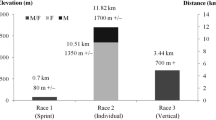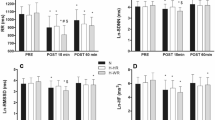Abstract
The autonomic and cardiovascular adaptations to hypoxia are opposite to those resulting from aerobic training. We investigated (1) whether exposure to hypoxia in a live high–train low (LHTL) session limits the autonomic and cardiovascular adaptations to training, and (2) whether such interactions remain 15 days after the end of the LHTL. Eighteen national swimmers trained for 13 days at 1,200 m, living (16 h day−1) either at 1,200 m (live low–train low, LLTL) or at a simulated height of 2,500–3,000 m (LHTL). Subjects were investigated at 1,200 m before and at the end of the training session, and after the following 15 days of sea-level training. Cardiovascular parameters and the autonomic control assessed by spectral analysis of R–R and diastolic blood pressure (DBP) variability were obtained in the resting supine position and in response to an orthostatic test. At the end of the 13-day training, resting heart rate (HR) and sympathetic modulation on heart decreased in LLTL (−10.1% and −25.4%, P<0.01, respectively) but not in LHTL (−5.8, −15.5%, respectively). Total peripheral resistance (TPR) and DBP became higher in LHTL than in LLTL (P<0.05). Stroke index decreased in both groups during the tilt test, counteracted by an increase in HR and sympathetic modulation to the heart and vasculature, and a decrease in vagal modulation to the heart. After the following 15-day sea-level training, differences in TPR and DBP between groups disappeared. During an LHTL session, adaptations to hypoxia interacted with the autonomic and cardiovascular adaptations to training. However, these interactions did not limit the adaptations to the following sea-level training.

Similar content being viewed by others
References
Akselrod S (1995) Components of heart rate variability: basic studies. In: Malik M, Camm AJ (eds) Heart rate variability. Futura Publishing Company, Armonk, pp 147–163
Arabi Y, Morgan BJ, Goodman B, Puleo DS, Xie A, Skatrud JB (1999) Daytime blood pressure elevation after nocturnal hypoxia. J Appl Physiol 87:689–698
Avalos M, Hellard P, Chatard JC (2003) Modeling the training-performance relationship using a mixed model in elite swimmers. Med Sci Sports Exerc 35:838–846
Beitzke M, Pfister P, Fortin J, Skrabal F (2002) Autonomic dysfunction and hemodynamics in vitamin B12 deficiency. Auton Neurosci 97:45–54
Bernardi L, Passino C, Spadacini G, Calciati A, Robergs R, Greene R, Martignoni E, Anand I, Appenzeller O (1998) Cardiovascular autonomic modulation and activity of carotid baroreceptors at altitude. Clin Sci (Lond) 95:565–573
Bernardi L, Wdowczyk-Szulc J, Valenti C, Castoldi S, Passino C, Spadacini G, Sleight P (2000) Effects of controlled breathing, mental activity and mental stress with or without verbalisation on heart rate variability. J Am Coll Cardiol 35:1462–1469
Bonaduce D, Petretta M, Cavallaro V, Apicella C, Ianniciello A, Romano M, Breglio R, Marciano F (1998) Intensive training and cardiac autonomic control in high level athletes. Med Sci Sports Exerc 30:691–696
Brugniaux JV, Schmitt L, Robach P, Jeanvoine H, Zimmermann H, Nicolet G, Duvallet A, Fouillot JP, Richalet JP (2005) Living high—training low: tolerance and acclimatization in elite endurance athletes. Eur J Appl Physiol (in press)
Cleroux J, Kouame N, Nadeau A, Coulombe D, Lacourciere Y (1992) Aftereffects of exercise on regional and systemic hemodynamics in hypertension. Hypertension 19:183–91
Cornolo J, Mollard P, Brugniaux JV, Robach P, Richalet JP (2004) Autonomic control of the cardiovascular system during acclimatization to high altitude: effects of sildenafil. J Appl Physiol 97:935–940
Eckert S, Lotz N, Bergemann C, Kemper B, Petzoldt R, Tschöpe D, Horstkotte D (2003) Autonomic dysfunction indicated by reduced baroflex sensitivity in patients with diabetes mellitus. In: Thirteenth European Meeting on Hypertension. Milan, Italy
Franke WD, Mills KK, Lee K, Hernandez JP (2003) Training mode does not affect orthostatic tolerance in chronically exercising subjects. Eur J Appl Physiol 89:263–270
Fu Q, Witkowski S, Levine BD (2004) Vasoconstrictor reserve and sympathetic neural control of orthostasis. Circulation 110:2931–2937
Furlan R, Piazza S, Dell’Orto S, Gentile E, Cerutti S, Pagani M, Malliani A (1993) Early and late effects of exercise and athletic training on neural mechanisms controlling heart rate. Cardiovasc Res 27:482–488
Gratze G, Fortin J, Holler A, Grasenick K, Pfurtscheller G, Wach P, Schönegger J, Kotanko P, Skrabal F (1998) A software package for non-invasive, real-time beat-to-beat monitoring of stroke volume, blood pressure, total peripheral resistance and for assessment of autonomic function. Comput Biol Med 28:121–142
Howard MG, Collins HL, Dicarlo SE (2000) Post-exercise elevations in sympathetic nerve activity and baroreflex function in normotensive rabbits. Clin Exp Hypertens 22:431–444
Iellamo F, Legramante JM, Pigozzi F, Spataro A, Norbiato G, Lucini D, Pagani M (2002) Conversion from vagal to sympathetic predominance with strenuous training in high-performance world class athletes. Circulation 105:2719–2724
Iwasaki KI, Zhang R, Zuckerman JH, Levine BD (2003) Dose-response relationship of the cardiovascular adaptation to endurance training in healthy adults: how much training for what benefit? J Appl Physiol 95:1575–1583
Levine BD, Stray-Gundersen J (1992) A practical approach to altitude training: where to leave and train for optimal performance enhancement. Int J Sports Med 13:S209–S212
Mourot L, Bouhaddi M, Tordi N, Rouillon JD, Regnard J (2004) Short- and long-term effects of a single bout of exercise on heart rate variability: comparison between constant and interval training exercises. Eur J Appl Physiol 92:508–517
Mujika I, Busso T, Lacoste L, Barale F, Geyssant A, Chatard JC (1996) Modeled responses to training and taper in competitive swimmers. Med Sci Sports Exerc 28:251–258
Nakamura Y, Yamamoto Y, Muraoka I (1993) Autonomic control of heart rate during physical exercise and fractal dimension of heart rate variability. J Appl Physiol 74:875–881
Pagani M, Montano N, Porta A, Malliani A, Abboud F, Birkett C, Somers VK (1997) Relationship between spectral components of cardiovascular variabilities and direct measures of muscle sympathetic nerve activity in humans. Circulation 95:1441–1448
Parati G, Ongaro G, Bilot G, Glavina F, Castiglioni P, Di Rienzo M, Mancia G (2003) Non-invasive beat-to-beat blood pressure monitoring: new developments. Blood Press Monit 8:31–36
Pichot V, Busso T, Roche F, Garet M, Costes F, Duverney D, Lacour JR, Barthélémy JC. (2002) Autonomic adaptations to intensive and overload training periods: a laboratory study. Med Sci Sports Exerc 34:1660–1666
Robach P, Schmitt L, Brugniaux JV, Roels B, Millet G, Hellard P, Nicolet G, Duvallet A, Fouillot JP, Moutereau S, Lasne F, Pialoux V, Olsen NV, Richalet JP (2005) Living high—training low: effect on erythropoiesis and aerobic performance in highly-trained swimmers. Eur J Appl Physiol (in press)
Rusko HK, Tikkanen H, Paavolainen L, Hamalainen I, Kalliokoski K, Puranen A (1999) Effect of living in hypoxia and training in normoxia on sea-level \(\ifmmode\expandafter\dot\else\expandafter\.\fi{V}{\text{O}}_{{{\text{2max}}}} \) and red cell mass. Med Sci Sports Exerc 31:S86
Tank J, Baevski RM, Fender A, Baevski AR, Graves KF, Ploewka K, Weck M (2000) Reference values of indices of spontaneous baroreceptor reflex sensitivity. Am J Hypertens 13:268–275
Task Force of the European Society of Cardiology, the North American Society of pacing and Electrophysiology (1996) Heart rate variability. Standards of measurement, physiological interpretation, and clinical use. Circulation 93:1043–1065
Task Force on Syncope, European Society of Cardiology (2001) Guidelines on management (diagnosis and treatment) of syncope. Eur Heart J 22:1256–1306
Terziotti P, Schena F, Gulli G, Cevese A (2001) Post-exercise recovery of autonomic cardiovascular control: a study by spectrum and cross-spectrum analysis in humans. Eur J Appl Physiol 84:187–194
Xie A, Skatrud JB, Puleo DS, Morgan BJ (2001) Exposure to hypoxia produces long-lasting sympathetic activation in humans. J Appl Physiol 91:1555–1562
Yamamoto K, Miyachi M, Saitoh T, Yoshioka A, Onodera S (2001) Effects of endurance training on resting and post-exercise cardiac autonomic control. Med Sci Sports Exerc 33:1496–1502
Zhang R, Iwasaki K, Zuckerman JH, Behbehani K, Crandall CG, Levine BD (2002) Mechanism of blood pressure and R–R variability: insights from ganglion blockade in humans. J Physiol (Lond) 543:337–348
Acknowledgements
The author thanks the Fédération Française de Natation and all the volunteers for their participation in this study at the Centre National de Ski Nordique (Prémanon, Jura). This project was supported by the International Olympic Committee and the French Ministry of Sports.
Author information
Authors and Affiliations
Corresponding author
Rights and permissions
About this article
Cite this article
Cornolo, J., Fouillot, JP., Schmitt, L. et al. Interactions between exposure to hypoxia and the training-induced autonomic adaptations in a “live high–train low” session. Eur J Appl Physiol 96, 389–396 (2006). https://doi.org/10.1007/s00421-005-0083-7
Accepted:
Published:
Issue Date:
DOI: https://doi.org/10.1007/s00421-005-0083-7




